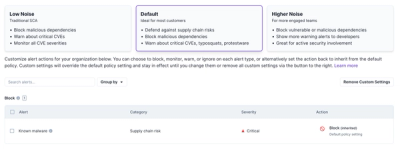node-cmdln is a node.js helper lib for creating CLI tools with subcommands
(think git, svn, zfs, brew, etc.). It is a sister of my earlier
Python lib for this.
Follow @trentmick
for updates to node-cmdln.
Usage
You define a subclass of Cmdln and subcommands as do_NAME methods.
Minimally you could have a "conan.js" as follows:
#!/usr/bin/env node
var util = require('util');
var cmdln = require('cmdln');
function Conan() {
cmdln.Cmdln.call(this, {
name: 'conan',
desc: 'What is best in life?'
});
}
util.inherits(Conan, cmdln.Cmdln);
Conan.prototype.do_crush = function do_crush(subcmd, opts, args, cb) {
console.log('Yargh!');
cb();
};
Conan.prototype.do_crush.help = 'Crush your enemies.';
cmdln.main(new Conan());
With this, you get the following behaviour:
$ node examples/conan.js
What is best in life?
Usage:
conan [OPTIONS] COMMAND [ARGS...]
conan help COMMAND
Options:
-h, --help Show this help message and exit.
Commands:
help (?) Help on a specific sub-command.
crush Crush your enemies.
$ node examples/conan.js help crush
Crush your enemies.
$ node examples/conan.js crush
Yargh!
Option processing
Option processing (using dashdash)
is integrated. do_crush above could be replaced with:
Conan.prototype.do_crush = function (subcmd, opts, args, cb) {
if (opts.help) {
this.do_help('help', {}, [subcmd], cb);
return;
}
if (!args.length) {
console.log('No enemies? Yarg!');
} else {
args.forEach(function (enemy) {
console.log('Smite %s with a %s!', enemy, opts.weapon);
});
}
cb();
};
Conan.prototype.do_crush.options = [
{
names: ['help', 'h'],
type: 'bool',
help: 'Show this help.'
},
{
names: ['weapon', 'w'],
helpArg: 'WEAPON',
type: 'string',
default: 'sword',
help: 'Weapon with which to smite.'
}
];
Conan.prototype.do_crush.help = (
'Crush your enemies.\n'
+ '\n'
+ 'Usage:\n'
+ ' {{name}} crush [OPTIONS] [ENEMIES...]\n'
+ '\n'
+ '{{options}}'
);
Then we get this behaviour:
$ node examples/conan.js crush Bob
Smite Bob with a sword!
$ node examples/conan.js crush Bob Linda --weapon mattock
Smite Bob with a mattock!
Smite Linda with a mattock!
$ node examples/conan.js crush -h
Crush your enemies.
Usage:
conan crush [OPTIONS] [ENEMIES...]
Options:
-h, --help Show this help.
-w WEAPON, --weapon=WEAPON Weapon with which to smite.
See examples/conan.js for the complete example. Run
node example/conan.js ... to try it out.
Reference
In general, please read the comments in the source and
browse the examples. The API is far from fully documented here.
cmdln.Cmdln
To use this module you create a class that inherits from cmdln.Cmdln; add
some methods to that class that define the tool's commands, options, etc.;
then pass an instance to cmdln.main(). Roughly like this:
function CLI() {
cmdln.Cmdln.call(this, {<config>});
}
util.inherits(CLI, cmdln.Cmdln);
...
var cli = new CLI();
cmdln.main(cli);
We'll use the CLI and cli names as used above in the following reference:
-
new Cmdln(<config>) Create a Cmdln subclass instance. See the block comment
in the code for full documentation on the config options.
-
CLI.prototype.do_<subcmd> = function (subcmd, opts, args, cb) is how a
subcommand is defined. How the subcmd is handled can be customize with some
properties (e.g. options, help) on the handler function.
-
CLI.prototype.do_<subcmd> = <SubCLI>; Alternatively a do_<subcmd> can
be set to another Cmdln subclass to support sub-subcommands, like
git remote add|remove|rename|.... See
"examples/fauxgit.js" for an example.
-
CLI.prototype.do_<subcmd>.options = <object>; is how to set the options
(in dashdash format) for that
subcommand.
-
CLI.prototype.do_<subcmd>.helpOpts = <dashdash helpOpts object>; to override
formatting settings for options help output for this command. By default
the helpOpts passed into the CLI constructor are used. The set of supported
helpOpts are defined by
dashdash.
-
CLI.prototype.do_<subcmd>.help = <string>; to set the help string for a
subcommand.
-
CLI.prototype.do_<subcmd>.help = function (subcmd, opts, args, cb) is
an alternate method to handle help for a subcommand. The given function
will be run when tool help <subcmd> is called.
-
CLI.prototype.do_<subcmd>.desc = <string>; can be set to a short string
to be used in the tool help output to summarize subcmd. If not provided,
then the first line of do_<subcmd>.help will be used.
-
CLI.prototype.do_<subcmd>.hidden = <boolean>; Set to false to have
tool help output not list this subcmd.
-
<Cmdln>.prototype.init(opts, args, cb) Hook run after option processing
(this.opts is set), but before the subcommand handler is run.
-
<Cmdln>.prototype.fini(subcmd, cb) Hook run after the subcommand handler is
run.
-
<Cmdln>.showErrStack boolean. Set to true to have cmdln.main(), if used,
print a full stack on a shown error. When wanted, this is typically set
in If you want this option it is typically
set either
-
<Cmdln>.handlerFromSubcmd(<subcmd>) will return the appropriate
do_<subcmd> method that handles the given sub-command. This resolves
sub-command aliases.
cmdln.main()
This is a convenience method for driving the mainline of your script using
the your defined Cmdln subclass. There are a number of options to control
how it works. Read the block comment on that function in "lib/cmdln.js" for
the best docs.
License
MIT. See LICENSE.txt



